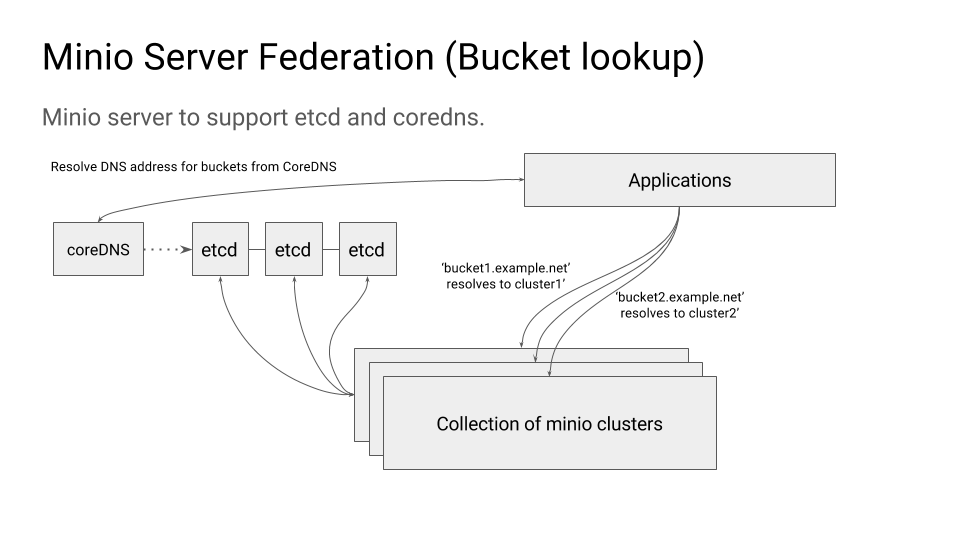mirror of
https://github.com/minio/minio.git
synced 2025-01-26 06:03:17 -05:00
etcd when used in federated setups, currently mandates that all clusters should have same config.json, which is too restrictive and makes federation a restrictive environment. This change makes it apparent that each cluster needs to be independently managed if necessary from `mc admin info` command line. Each cluster with in federation can have their own root credentials and as well as separate regions. This way buckets get further restrictions and allows for root creds to be not common across clusters/data centers. Existing data in etcd gets migrated to backend on each clusters, upon start. Once done users can change their config entries independently.
97 lines
5.2 KiB
Markdown
97 lines
5.2 KiB
Markdown
# Federation Quickstart Guide [](https://slack.min.io)
|
||
This document explains how to configure MinIO with `Bucket lookup from DNS` style federation.
|
||
|
||
## Get started
|
||
|
||
### 1. Prerequisites
|
||
Install MinIO - [MinIO Quickstart Guide](https://docs.min.io/docs/minio-quickstart-guide).
|
||
|
||
### 2. Run MinIO in federated mode
|
||
Bucket lookup from DNS federation requires two dependencies
|
||
|
||
- etcd (for bucket DNS service records)
|
||
- CoreDNS (for DNS management based on populated bucket DNS service records, optional)
|
||
|
||
## Architecture
|
||
|
||

|
||
|
||
### Environment variables
|
||
|
||
#### MINIO_ETCD_ENDPOINTS
|
||
|
||
This is comma separated list of etcd servers that you want to use as the MinIO federation back-end. This should
|
||
be same across the federated deployment, i.e. all the MinIO instances within a federated deployment should use same
|
||
etcd back-end.
|
||
|
||
#### MINIO_DOMAIN
|
||
|
||
This is the top level domain name used for the federated setup. This domain name should ideally resolve to a load-balancer
|
||
running in front of all the federated MinIO instances. The domain name is used to create sub domain entries to etcd. For
|
||
example, if the domain is set to `domain.com`, the buckets `bucket1`, `bucket2` will be accessible as `bucket1.domain.com`
|
||
and `bucket2.domain.com`.
|
||
|
||
#### MINIO_PUBLIC_IPS
|
||
|
||
This is comma separated list of IP addresses to which buckets created on this MinIO instance will resolve to. For example,
|
||
a bucket `bucket1` created on current MinIO instance will be accessible as `bucket1.domain.com`, and the DNS entry for
|
||
`bucket1.domain.com` will point to IP address set in `MINIO_PUBLIC_IPS`.
|
||
|
||
*Note*
|
||
|
||
- This field is mandatory for standalone and erasure code MinIO server deployments, to enable federated mode.
|
||
- This field is optional for distributed deployments. If you don't set this field in a federated setup, we use the IP addresses of
|
||
hosts passed to the MinIO server startup and use them for DNS entries.
|
||
|
||
### Run Multiple Clusters
|
||
|
||
> cluster1
|
||
|
||
```sh
|
||
export MINIO_ETCD_ENDPOINTS="http://remote-etcd1:2379,http://remote-etcd2:4001"
|
||
export MINIO_DOMAIN=domain.com
|
||
export MINIO_PUBLIC_IPS=44.35.2.1,44.35.2.2,44.35.2.3,44.35.2.4
|
||
minio server http://rack{1...4}.host{1...4}.domain.com/mnt/export{1...32}
|
||
```
|
||
|
||
> cluster2
|
||
|
||
```sh
|
||
export MINIO_ETCD_ENDPOINTS="http://remote-etcd1:2379,http://remote-etcd2:4001"
|
||
export MINIO_DOMAIN=domain.com
|
||
export MINIO_PUBLIC_IPS=44.35.1.1,44.35.1.2,44.35.1.3,44.35.1.4
|
||
minio server http://rack{5...8}.host{5...8}.domain.com/mnt/export{1...32}
|
||
```
|
||
|
||
In this configuration you can see `MINIO_ETCD_ENDPOINTS` points to the etcd backend which manages MinIO's
|
||
`config.json` and bucket DNS SRV records. `MINIO_DOMAIN` indicates the domain suffix for the bucket which
|
||
will be used to resolve bucket through DNS. For example if you have a bucket such as `mybucket`, the
|
||
client can use now `mybucket.domain.com` to directly resolve itself to the right cluster. `MINIO_PUBLIC_IPS`
|
||
points to the public IP address where each cluster might be accessible, this is unique for each cluster.
|
||
|
||
NOTE: `mybucket` only exists on one cluster either `cluster1` or `cluster2` this is random and
|
||
is decided by how `domain.com` gets resolved, if there is a round-robin DNS on `domain.com` then
|
||
it is randomized which cluster might provision the bucket.
|
||
|
||
### 3. Upgrading to `etcdv3` API
|
||
|
||
Users running MinIO federation from release `RELEASE.2018-06-09T03-43-35Z` to `RELEASE.2018-07-10T01-42-11Z`, should migrate the existing bucket data on etcd server to `etcdv3` API, and update CoreDNS version to `1.2.0` before updating their MinIO server to the latest version.
|
||
|
||
Here is some background on why this is needed - MinIO server release `RELEASE.2018-06-09T03-43-35Z` to `RELEASE.2018-07-10T01-42-11Z` used etcdv2 API to store bucket data to etcd server. This was due to `etcdv3` support not available for CoreDNS server. So, even if MinIO used `etcdv3` API to store bucket data, CoreDNS wouldn't be able to read and serve it as DNS records.
|
||
|
||
Now that CoreDNS [supports etcdv3](https://coredns.io/2018/07/11/coredns-1.2.0-release/), MinIO server uses `etcdv3` API to store bucket data to etcd server. As `etcdv2` and `etcdv3` APIs are not compatible, data stored using `etcdv2` API is not visible to the `etcdv3` API. So, bucket data stored by previous MinIO version will not be visible to current MinIO version, until a migration is done.
|
||
|
||
CoreOS team has documented the steps required to migrate existing data from `etcdv2` to `etcdv3` in [this blog post](https://coreos.com/blog/migrating-applications-etcd-v3.html). Please refer the post and migrate etcd data to `etcdv3` API.
|
||
|
||
### 4. Test your setup
|
||
|
||
To test this setup, access the MinIO server via browser or [`mc`](https://docs.min.io/docs/minio-client-quickstart-guide). You’ll see the uploaded files are accessible from the all the MinIO endpoints.
|
||
|
||
# Explore Further
|
||
|
||
- [Use `mc` with MinIO Server](https://docs.min.io/docs/minio-client-quickstart-guide)
|
||
- [Use `aws-cli` with MinIO Server](https://docs.min.io/docs/aws-cli-with-minio)
|
||
- [Use `s3cmd` with MinIO Server](https://docs.min.io/docs/s3cmd-with-minio)
|
||
- [Use `minio-go` SDK with MinIO Server](https://docs.min.io/docs/golang-client-quickstart-guide)
|
||
- [The MinIO documentation website](https://docs.min.io)
|